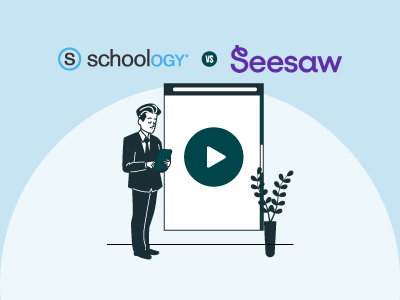
Approximately 63% of K–12 students in the U.S. use online learning tools daily, demonstrating the growing role of online platforms in education. In this digital landscape, software options like Schoology and Seesaw play key roles in shaping student learning.
Schoology offers a comprehensive learning management system (LMS) with advanced features like course creation, artificial intelligence (AI), and powerful analytics, making it suitable for K–12, higher education, and corporate training. Seesaw, on the other hand, emphasizes student portfolios and multimodal learning tools, providing a personalized and user-friendly experience for younger learners.
However, there's much more to each platform than it first appears. This Schoology vs Seesaw guide will help you understand their strengths and assist in selecting the right tool for your teaching needs.
Feature | Schoology | Seesaw |
Content Creation And Customization | Uses AI (PowerBuddy) for customizable content creation | Offers standards-aligned lessons and multimodal tools for PreK–6 |
Student Assessments | Integrates with ‘Performance Matters’ for diverse assessments and insights | Portfolio-based assessments with multimodal features like audio and video |
Reporting And Analytics | Combines data from multiple sources for detailed insights | Provides formative reports and progress dashboards |
Digital Student Portfolios | Centralized space to showcase assignments and online content | Multimodal portfolios that track student growth over time |
Mobile Application | Available on iOS and Android, with essential tools for managing classes and assignments | Available on iOS and Android, allowing real-time communication and updates |
Developed by PowerSchool, Schoology LMS is a cloud-based platform designed to support K–12 schools in delivering engaging, personalized education. Key features include assignments, assessments, gradebooks, discussion boards, and seamless integration with student information systems (SIS) and third-party apps.
Teachers can use Schoology to create, manage, and share academic content while facilitating communication and collaboration among students, educators, and parents. The platform is widely used for blended and remote learning environments and emphasizes accessibility, equity, and curriculum customization.
Unique Features Of Schoology

Pros And Cons Of Schoology
Pros
- Attaches Google Docs to assignments, automatically renaming and saving a copy to each student’s Drive for version control
- Teachers can set rules that control student progression through activities, promoting self-paced learning while maintaining course structure
- Users can enrich course content by embedding videos, images, hyperlinks, and interactive elements directly into pages, folders, and announcements
- The platform offers multiple quiz and test question types with automated grading, saving teachers time on assessments
Cons
- Only admins can delete or unassign courses, limiting flexibility for teachers managing their content
- Auto-graded questions may mark correct responses wrong due to minor formatting issues, adding to teacher workload
Seesaw LMS is a digital learning platform designed for students from PreK through 6th grade. It offers tools that support differentiated instruction, family engagement, and curriculum delivery. The platform also features multimodal tools, digital portfolios, assessments, and a rich lessons library to improve learning initiatives.
With AI-enhanced instruction, accessibility options, and seamless integrations, Seesaw supports core subjects, early literacy, and English language development. Educators also benefit from ongoing professional development through the Learning Hub, webinars, and live events, making it a complete classroom companion.
Unique Feature Of Seesaw

Pros And Cons Of Seesaw
Pros
- Parents get real-time updates on their child’s work and classroom activities, enhancing communication and engagement
- Teachers can assign auto-graded assessments, thus saving time and providing quick feedback to students
- Seesaw offers a wide range of teacher-created activities, and the flexibility to create personalized assignments for individual student needs
Cons
- Admins have limited functionality on the mobile app and may face challenges with navigation and customization
- Important information like assignments, messages, and updates can be spread across different tabs, leading to potential confusion

Content Creation And Customization

Student Assessments

Reporting And Analytics

Digital Student Portfolios

Mobile Application

Both Schoology and Seesaw offer distinct advantages, depending on the learning context. Schoology is ideal for institutions and organizations that require advanced features like course creation, grading, detailed analytics, and AI-powered tools. Its scalability, SCORM support, and deep integration with other systems make it perfect for K–12, higher education, and corporate training environments.
In contrast, Seesaw is designed with younger learners in mind, offering a more user-friendly, portfolio-based approach to learning. It empowers students to showcase their creativity through multimodal tools like videos, photos, and audio recordings, providing teachers with personalized insights into student progress. This makes it ideal for early education settings and classrooms, fostering student engagement and reflection more visually and interactively.
Ultimately, the right choice depends on your students' age, your teaching objectives, and the complexity of the tools you need. If you're focused on managing large-scale courses and data, Schoology is the way to go to get the best benefits of the LMS. For fostering creativity and tracking student progress in early education, Seesaw stands out as the best fit.
